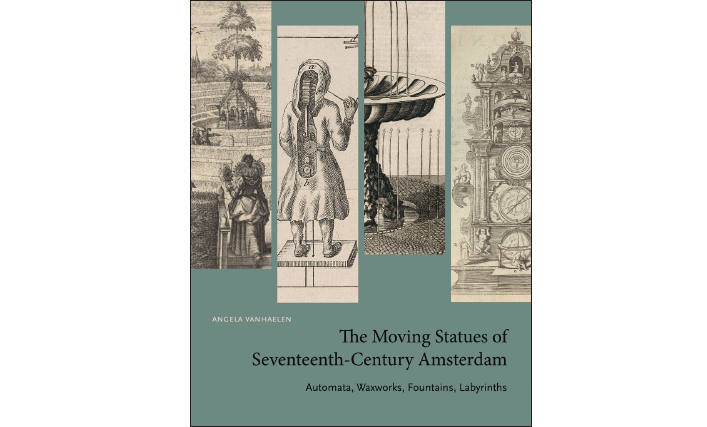Early art theory understood the concept of ‘moving image’ in two ways. The first was a sense of animation as a subject itself — crafted bodies, for example, that run or seem to run, banners that flutter. The second, more ambiguous, referred to affect, or the transformative possibilities that scenes or spaces spurred in viewers, the feeling akin to being ‘moved’ by a piece of music. Alberti provides a period summation of both these processes:
A historia will move spectators when the men painted in the picture outwardly demonstrate their own feelings as clearly as possible. Nature provides and there is nothing to be found more rapacious of her than she — that we mourn with the mourners, laugh with those who laugh, and grieve with the grief-stricken. Yet these feelings are known from movements [motibus] of the body. (1991: 73)
Movement (moto) of the mind and body are basically two different components of the same concept. The Netherlandish rhetorician and art theorist Karel van Mander in 1604, too, wrote of beweghen as bodily movement and theatricality, the parity of which, as Leonardo put it, constituted painting’s justification: ‘painting is proved to be philosophy because it treats the motion of bodies and the rapidity of their actions and philosophy also includes motion. Painting is therefore philosophy because philosophy treats of the increase and decrease of motions’ (da Vinci 1956: I:5). Art, through such an association, is traditionally demystified; the apprehensibility of motion is a process that almost transcends discursive practices. Icons, like good painting, were frequently understood as being animated by a type of phenomenological experience. Miraculous icons came alive through the phenomenological experience of their architectural surroundings. The sole words that survive by Rembrandt about his own art mention ‘beweechgelickheijt’ — the condition of motion and expression — that the artist claimed to have included in his Resurrection of 1639, now in Munich.
Rembrandt’s ambit, and an explosively new understanding of what is now known as beweeglijkheid anchor Angela Vanhaelen’s new book. Centered upon little-studied urban environments called doolhoven (or loosely, ‘maze-courts’), this study of hybrid carnival-labyrinth parks attempts a reconstruction of objects and experiences that have physically vanished. Movement, it implies, was the metaphorical and literal crux of the doolhof – like the midway. Not simply in the sense of walking, looking, and hearing simulated life (androids were a huge part of the scene, as was drinking), but in the sense of social coercion. Paying visitors to the doolhof were directed into labyrinths, exposed to talking statues, and splashed by marvelous fountains. This was subjection to forces that, as Vanhaelen concludes (quietly), ‘aimed to completely eliminate non-Reformed religions and diverse culture’ (163). Automata in the gardens, charming and mimetic, were, for example, essentially slaves — a chilling rhyme with the actual (unseen) people being brutalized to enrich Amsterdam’s bourgeoisie. Almost never have studies of what tend to be thoughtlessly called ‘marvels’, ‘curiosities’, or the Dutch ‘golden age’ ventured to propose this connection of injustices, and for this argument alone, Vanhaelen’s book is vital. Although full of new archival finds, the book’s title does not do its grander claims justice. Moving Statues is not really a study of machines (although it deals expertly with the form and function of clocks and robots, for example), but it addresses exhibition culture and power in early capitalism. The real moving statues of early modern Amsterdam were its Calvinist citizens.
The doolhof was not easily classed as ‘popular’ or ‘elite’ (although 19th-century historians, mostly from an increasingly anxious middle class, tried to) and was something different than the agora, the public park, the Passagen. Disneyland — Baudrillard’s now shopworn-sounding ‘deterrence machine’ — seems to offer one model to frame the doolhof that Vanhaelen is describing; unlike a fair, it was permanent. But Moving Statues has a more subtle, more historical point to make about the installations. In a newly independent Dutch Republic, ‘space’ itself was a paradoxical concept. Like water (Chapter Two’s focus), it exists as a habitat and a (literal) source of power. Vanhalen’s book, like the doolhof itself, is full of so many surprises that simply are too good to give away (one spoiler: Jochum, the bagpipe-playing robot, pp. 98ff). As a result, this reader (who was fortunate enough to read the book while in present-day Amsterdam) found himself seeking out physical addresses of now-vanished sites. Movement indeed. In the guise of a study of what was, for decades, called ‘the curious’, this book recasts the very notion of Dutch art as one of description. It has no patience with (say) the idea of architecture as somatically and historically immobile.
Enda Duffy has noted that modern technology’s promise of seeing more by moving fast (in transportation vehicles, for example, or film) has often wrought the exact opposite, in life and scholarship alike. In early modern Amsterdam, as Vanhaelen colorfully shows, visual culture was defined not just by how it looked back to history and imaged old stories, but how it slowed themes and people — often against their will — though bewildering presents.
Competing Interests
The author has no competing interests to declare.
References
Alberti, LB. 1991. On Painting. Grayson, C (trans.). London: Penguin.
da Vinci, Leonardo. 1956. Treatise on Painting (Codex urbinas latinus 1270). McMahon (trans.). Princeton: Princeton University Press.
Duffy, Enda 2008. The Speed Handbook: Velocity, Pleasure, Modernism. Durham: Duke University Press. DOI: http://doi.org/10.1215/9780822392378
